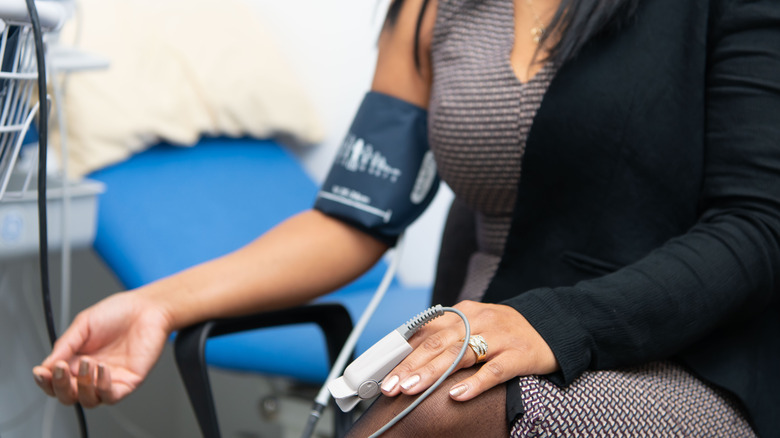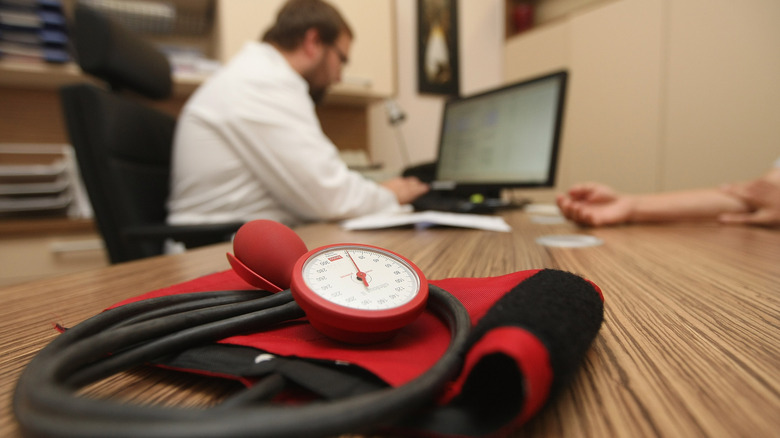

Blood pressure screening is an integral component of preventive care. Medical professionals use this test to detect hypertension, a condition that affects nearly half of U.S. adults (per the Centers for Disease Control and Prevention). Hypertension, or high blood pressure, may contribute to heart disease, stroke, and cardiac failure.
This condition also affects your brain, eyes, kidneys, and arteries, leading to serious health problems. For example, it can increase your risk of mild cognitive impairment and dementia, warns the Mayo Clinic. Some people may experience sexual problems or nerve damage as a result of high blood pressure. In severe cases, hypertension can lead to memory loss, kidney failure, and other conditions that require emergency care.
While it’s true that anyone can have high blood pressure, its prevalence increases with age. The CDC reports that more than 22% of adults aged 18 to 39, 54% of those aged 40 to 59, and 74% of seniors over 60 years old live with this condition. Hypertension rarely has any symptoms — and that’s why it’s called the “silent killer,” notes the American Heart Association. The only way to detect it is to get your blood pressure checked regularly.
How blood pressure is tested

Healthy adults aged 18 to 39 years should have their blood pressure checked every three to five years (per the American Academy of Family Physicians). Individuals over 40 years old and those at risk for hypertension should get annual screenings. Currently, there are no set guidelines for children and teens. If you have a child, ask your doctor to test his blood pressure during routine checkups.
Try to avoid exercise, smoking, and caffeine consumption for 30 to 60 minutes before the screening. These activities raise blood pressure, says the Mayo Clinic. Ideally, take a few moments to relax while waiting for the doctor. Make sure you let him know about any drugs you take. Painkillers, antidepressants, decongestants, and other medications may increase your blood pressure and affect the test results (via the Mayo Clinic). The same goes for certain supplements, such as arnica, licorice, and ginseng.
A blood pressure screening doesn’t cause pain or discomfort. The nurse or doctor will ask you to sit in a chair and rest your arm on a table. Next, they will place a cuff around your upper arm and pump it up to restrict blood flow. The pneumatic cuff is attached to a blood pressure monitor (sphygmomanometer). Your doctor will slowly release the pressure in the cuff and then use a stethoscope to measure your pulse and blood pressure. Some medical professionals use automatic devices instead of stethoscopes.
Blood pressure screening results can tell a lot about your health

The test measures both your systolic and diastolic blood pressure. The top number shows your systolic blood pressure, or the force of blood against the artery walls when the heart muscle is contracting. The second number is your diastolic blood pressure, or the force of blood inside the arteries when the heart is resting. Normal blood pressure is under 120/80 mm Hg (millimeters of mercury), explains the American Heart Association. Anything above these values should raise a red flag.
Both systolic and diastolic blood pressure readings are important, states the American Heart Association. However, systolic blood pressure tends to increase with age due to plaque buildup and other health problems. For this reason, it’s commonly used to predict heart disease risk. Medical professionals look at both numbers when making a diagnosis.
Don’t panic if your blood pressure screening results are higher than normal. From cutting back on salt to getting more exercise, there are steps you can take to bring these numbers down. “It is well documented that lifestyle changes can lower blood pressure as much as pills can, and sometimes even more,” Dr. as Naomi Fisher told Harvard Medical School. Simple things, such as limiting stress and starting a strength training program, can make all the difference.
Source: Read Full Article